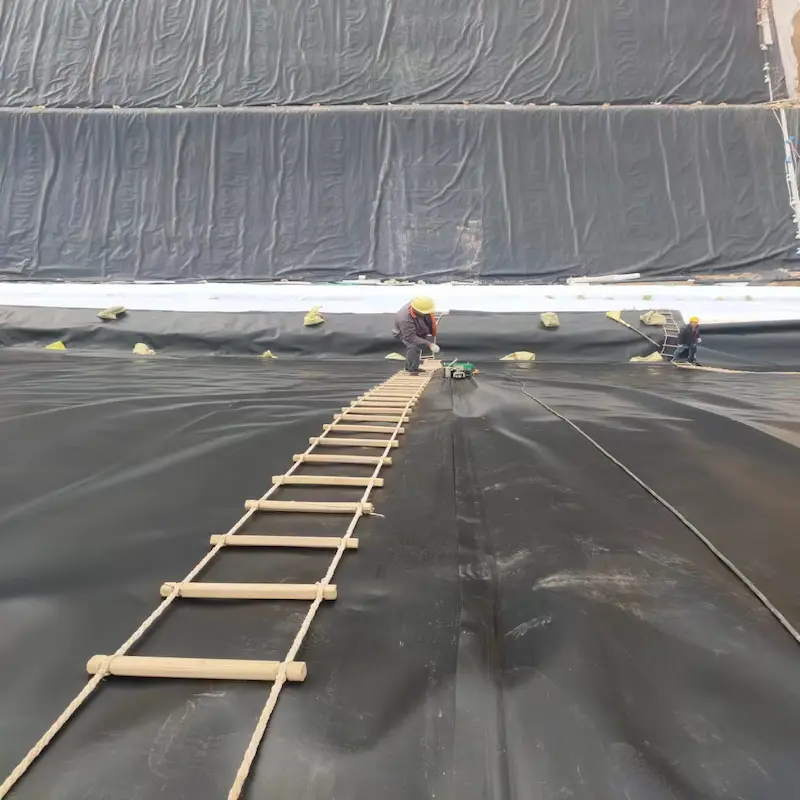What is geomembrane?
A geomembrane is a synthetic membrane typically used as a barrier in construction to control the movement of liquids, gases, or other materials. It plays a crucial role in various civil engineering and environmental projects, particularly in situations where containment or protection from contamination is required. Geomembranes are widely used in landfills, waste containment systems, water reservoirs

Key Geomembrane Specifications in Construction
Property | Specification Range |
Material | HDPE, LDPE, PVC, EPDM |
Thickness | 0.5 mm to 3.0 mm |
Density | 0.91–0.98 g/cm³ (HDPE) |
0.91–0.98 g/cm³ (HDPE) | 25 MPa to 35 MPa (HDPE) |
Elongation at Break | 300% to 700% (HDPE) |
Puncture Resistance | 1,000 N to 2,500 N (HDPE) |
Chemical Resistance | Excellent (for HDPE) |
UV Resistance | UV stabilized (HDPE with carbon black) |
Temperature Resistance | -50°C to 60°C (HDPE) |
Permeability | ≤ 10^- |
Applications of Geomembrane in Construction
Geomembranes are versatile and find applications in several construction areas:
Application Area
| Use Case
| Key Benefits
|
Environmental
| Landfill liners, leachate ponds
| Prevents contamination, durable
|
Water Management
| Reservoirs, canals, aquaculture ponds
| Reduces seepage, long lifespan
|
Mining
| Tailings storage, heap leach pads
| Tailings storage, heap leach pads
|
Tailings storage, heap leach pads
| Tunnels, road stabilization
| Enhances structural integrity
|
Benefits of Geomembranes
1. Excellent Impermeability
· Primary Function: Geomembranes are primarily designed to act as impermeable barriers, preventing the flow of liquids, gases, and contaminants through the material. This makes them highly effective for:
Landfill liners (to prevent leachate from contaminating groundwater).
Pond and reservoir liners (to reduce water seepage).
Wastewater treatment systems (to control wastewater leakage).
Containment of hazardous materials (in mining or industrial waste sites).
· Permeability: Geomembranes typically have a permeability of less than 10^-13 m/s, which ensures that harmful substances do not migrate into the surrounding environment.
2. Durability and Longevity
· Chemical Resistance: Geomembranes, especially those made of HDPE (High-Density Polyethylene), are highly resistant to a wide range of chemicals, including acids, alkalis, oils, solvents, and salts. This makes them ideal for:
Landfills (to contain leachate).
Mining applications (to resist chemicals like cyanide and other toxic materials).
Agricultural applications (to prevent contamination from fertilizers or pesticides).
· UV Resistance: Many geomembranes are UV-stabilized, especially those used outdoors, which protects them from degradation caused by sun exposure. Carbon black is commonly added to HDPE geomembranes to enhance UV stability.
· Long-Term Performance: When properly installed, geomembranes can provide decades of service, even in harsh environments. They can withstand extreme temperatures, varying soil conditions, and heavy mechanical loads.
3. Flexibility
· Adaptability to Substrates: Geomembranes are often flexible, which allows them to adapt to uneven or shifting ground conditions. This characteristic makes them ideal for:
Waste containment: where the underlying soil may shift over time.
Waterproofing foundations: where the surface may not be perfectly smooth.
· Ease of Installation: Geomembranes can be manufactured in large rolls, which minimizes the number of seams and simplifies installation. They can be welded together at the site, reducing installation time and ensuring high integrity.
4. Cost-Effectiveness
·Lower Material and Labor Costs: Geomembranes are often more affordable than alternatives like clay liners, which require intensive labor and more complex installation procedures. Additionally, geomembranes can be installed quickly and easily, reducing overall labor costs.
·Reduced Maintenance Costs: Due to their long-lasting properties and low wear and tear, geomembranes require minimal maintenance, leading to lower long-term costs.

Performance Data and Material Comparison
Different geomembrane materials have varying properties. Here’s a comparative analysis:
Property | HDPE (High-Density Polyethylene) | LLDPE (Linear Low-Density Polyethylene) | PVC (Polyvinyl Chloride) |
Thickness (mm) | 0.5–2.5
| 0.5–2.0 | 0.5–2.0 |
Tensile Strength
| High
| Medium
| Medium
|
Flexibility
| Low
| High
| High
|
UV Resistance | Excellent | Good | Moderate |
Chemical Resistance | Excellent | Good | Moderate |
Cost ($/m²) | 2–4 | 1.5–3 | 2–4 |
Standards for Geomembranes in Construction
Several international and national standards govern the production, testing, and application of geomembranes to ensure that they meet required performance criteria. These standards are critical for ensuring the reliability and safety of geomembrane applications.
1. ASTM Standards
The American Society for Testing and Materials (ASTM) provides a range of standards that define the requirements for geomembranes:
ASTM D5199: Standard Test Method for Measuring the Nominal Thickness of Geomembranes.
ASTM D6392: Standard Test Method for Determining the Tensile Properties of Geomembranes.
ASTM D5747: Standard Guide for the Selection of Geomembranes for the Control of Leachate from Solid Waste Landfills.
2. ISO Standards
The International Organization for Standardization (ISO) also provides guidelines for the design and testing of geomembranes:
ISO 9001: Quality Management Systems (for manufacturers).
ISO 13434: Geosynthetics — Guidelines for the Use of Geomembranes.
3. EN Standards (Europe)
EN 13491: Geomembranes for use in the construction of waste containment facilities.
EN 13361: Geomembranes used in hydraulic structures.
Other Standards
Many countries have their own standards for geomembranes, such as the British Standard (BS), Australian Standard (AS), and others, which govern the performance and specifications of geomembranes in construction.
Geomembranes are essential components in construction projects where containment, waterproofing, or environmental protection is needed. Their durability, flexibility, and cost-effectiveness make them ideal for a wide range of applications, particularly in landfills, reservoirs, and wastewater systems. However, careful installation, material selection, and quality control are critical to ensure their long-term performance.

897.webp)
942.webp)
237.webp)